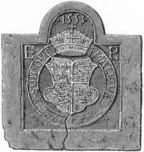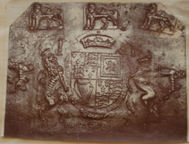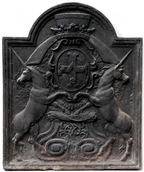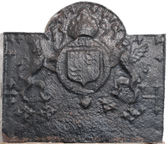-
467
Description: Arched rectangular with plain edges; arched rectangular inset with cavetto edging and armorial design in low relief: circular garter enclosing an ornate Tudor royal shield, surmounted by a crown; date inside top of arch; initials inside top corners of rectangle
Notes: Discovered by Mr Anthony Hill of the Plymouth ironworks, Glamorgan, in the 1820s, and believed by David Mushet, in his 'Papers on Iron and Steel' to have been cast at the early furnace on the opposite side of the River Taff; a variant of the same date (no. 288) has an inscription on the bottom panel and roses in relief at the bottom corners of the rectangle, which may have been obliterated by fire damage on this casting, the drawing showing it how the artist thought it might have looked originally. The west country source for both of these firebacks offers the possibility of an origin in those parts.
Inscription: HONV SOIT QVE MALE V [illegible]
Arms: Tudor royal - Edward VI
- Decoration tags:
- rectangular with round arch (shape)
- none (edging)
- whole carved pattern
- armorial
- royal
- text
Manufactured: in 1553 .
Current location: not known.
Citation: Mushet, D., 1840, Papers on Iron and Steel (London, John Weale), p. 393.
- Attached to series:
- Edwardian royal armorial firebacks
- Tudor royal armorial firebacks
-
1060
 ? x ? mm
? x ? mmDescription: Central shield bearing a lion rampant reguardant, with esquire's helm and crest of a seated hawk, surrounded by foliage and tasselled ribbons; twisted rope edging at each side; the shape of the fireback is dictated by the decorative elements; initials split by shield, the date similarly split below the initials.
Notes: Drawing of a fireback from old premises, formerly a baker's, opposite 20 Love Lane (later known as Lovat Lane), which ran between Eastcheap and Lower Thames Street; the arms appear to be those of the Morrice family (blazon: gules, a lion rampant reguardant or). Drawn by Charles Raymond Booth Barrett, 1891. A fireback of unique design.
Inscription: W M / 15 86
Arms: Morrice or Maurice
- Decoration tags:
- complex individual (shape)
- complex individual (edging)
- whole carved pattern
- heraldic
- armorial
- text
- plants
Manufactured: in 1586 possibly in the Weald area of England.
Current location: not known.
Museum number: SC/GL/PR/370/LOV/1/q7706298 (part of the London Metropolitan Archives museum group)
Citation: Windyer Morris, G. T., 4 Oct 1902, 'Arms on Fireback', Notes and Queries, 9th series, 10, p. 278.
- Attached to series:
- Date & initials firebacks
-
474
Description: Fragment; arched rectangular shape with rounded corners; ovolo within fillet moulding all round; oval Tudor royal shield with garter surrounding, topped with a royal crown; dragon and greyhound supporters; initials split by crown; inscription on a fillet between legs of supporters, behind garter finial; motto on an Ionic plinth at bottom; left hand rectangular extension panel with twisted rope edging on top and side: initials in top left corner, ‘dragon’s head’ in top right corner, rose-en-soleil stamp in centre, rose stamp bottom centre.
Notes: The letters on the extension panel are the same form and size as those on the top of the armorial pattern, indicating that they were added to the armorial, perhaps to indicate a change of reign. The letter 'E' has also been noted on another fireback of the same series. The rose-en-soleil was the badge of King Edward IV and, thus, a Yorkist symbol; it is seen on other firebacks. From a house in Chailey, Sussex. Illustration from Lower (1849).
Inscription: E R / E / R / HONY SOIT QUE MAL Y PAYNCE / Made in Sussex by John Harvo / DV ET MOVN DR...
Arms: Tudor royal
- Decoration tags:
- rectangular with round arch (shape)
- complex individual (edging)
- carved stamps
- whole carved pattern
- individual letters
- armorial
- royal
- text
- animals
- plants
Manufactured: in the mid- to late-16th century in the Weald area of England.
Current location: not known.
- Attached to series:
- Pounsley series
- John Harvo series
- Rose-en-soleil series
-
870
Description: Arched rectangular shape with ovolo-moulded edging and narrow extensions to sides; central shield bearing arms with lion rampant supporters and motto scroll beneath; above, a marquesal coronet; date split between top corners; inserted initials above coronet; on top of arch, two downward facing dolphins with tails entwined.
Notes: The arms are of the family of Henry Pierrepont, marquess of Dorchester and earl of Kingston-upon-Hull, of Thoresby Hall, Nottinghamshire (blazon: argent semi of cinquefoils gules, a lion rampant sable), with the motto: Pie Repone Te (Place yourself piously), a pun on the name, Pierrepont. Confusingly, the marquisate of Dorchester was created twice for members of the same family. In 1645 it was created for Henry Pierrepont, 2nd earl of Kingston-upon-Hull, becoming extinct on his death without surviving male issue in 1680. It was created again for Evelyn Pierrepont, the 5th earl of Kingston in 1706 who was subsequently elevated to the dukedom of Kingston in 1715. The original casting may therefore have dated to between 1645 and 1680 or between 1706 and 1715. The initials may be related to the Halls, the 2nd Duke of Kingston's mother's family, and were probably added with the date in 1728. Woolley & Wallis auction, Salisbury, 8 Jul 2014, lot 518 (£250); Lyon and Turnbull auction, Edinburgh, 1 Sep 2021, lot 10.
Copies of this fireback are known.
Inscription: A H / 17 28 / PIE REPONE TE
Arms: Pierrepont, Marquess of Dorchester
- Decoration tags:
- rectangular with round arch (shape)
- ovolo (edging)
- whole carved pattern
- individual letters
- armorial
- text
Manufactured: in 1728 in England.
Current location: not known.
- Attached to series:
- Personal armorial firebacks
- Pierrepont series
-
480
Description: Arched rectangle; ovolo, egg-and-dart moulded edging; shield, helm, coronet, crest and mantling; curved inscription panel below shield.
Notes: The heraldic devices on the shield, and the form of the helm and crest suggest this may be a continental achievement of arms; the style of the fireback is, however, is more characteristic of English types.
Copies of this fireback are known.
Inscription: ... D HADRIANI ... EQVITE DOM DE HE.. / ... M.. ... ... [?]
Arms: not known
- Decoration tags:
- rectangular with round arch (shape)
- egg and dart (edging)
- whole carved pattern
- planklines
- armorial
- text
Manufactured: in the early-17th century .
Current location: Maidstone Museum, St Faith's Street, Maidstone, Kent, England.
(part of the Maidstone Museum museum group)
- Attached to series:
- Personal armorial firebacks
-
1036
Description: Canted rectangular shape; no edging; lower centre, carved pattern panel of Stuart Royal arms: shield, garter, crown, motto, supporters and initials, RI separated by crown; lion statant guardant stamp repeated five times, three across top, one each side feet to left.
Notes: The impression of the decorative elements is irregular, with the achievement of arms under-pressed and the three lion stamps along the top over-pressed; the distinctive feature of the unicorn's horn in front of the initial R has been seen on a small number of other firebacks. From a photograph in the J. Starkie Gardner Collection, Victoria & Albert Museum, Archive of Art and Design (AAD/2014/8).
Inscription: I R
Arms: English Stuart royal - James I
- Decoration tags:
- rectangular with canted top corners (shape)
- none (edging)
- carved stamps
- carved pattern panels
- heraldic
- armorial
- royal
- text
- animals
Manufactured: in the early-17th century possibly in the Weald area of England.
Current location: Maidstone Museum, St Faith's Street, Maidstone, Kent, England.
(part of the Maidstone Museum museum group)
-
1016
Description: Arched rectangular shape; ovolo-moulded edging; Tudor royal shield within a cartouche, garter, crown, motto and supporters (crowned lion and dragon); Tudor rose to right of lion’s head, portcullis to left of dragon’s head.
Notes: The cartouche enclosing the shield is an unusual feature. A recasting. Mallam's auction, Abingdon, 9 Aug 2014, lot 1208 (£100).
Inscription: Garter and Royal mottoes [not legible]
Arms: Tudor royal (prob. Elizabeth I)
- Decoration tags:
- rectangular with round arch (shape)
- ovolo (edging)
- whole carved pattern
- armorial
Manufactured: in the mid- to late-16th century in England.
Current location: not known.
- Attached to series:
- Tudor royal armorial firebacks
-
1045
Description: Arched rectangular shape; ovolo-moulded edging; top centre, oval shield of arms within a cartouche, supported by two unicorns rampant reguardant, their hooves resting on a scrolled compartment; behind the shield is the cape of the Président à mortier of the Parliament; above the shield, a velvet cap or mortar board of office within a coronet.
Notes: Blazon: azure, on a maltese cross argent a chevron gules between two mullets sable, and in base a rose gules. Louis-Michel Lepeletier, Marquis de Saint-Fargeau (1760-93) was a French parliamentarian. Having voted for the execution of Louis XVI Lepeletier was assassinated by a former guard of the king. The fireback dates from 1789 or later when Lepeletier was elected Président à mortier.
Arms: Louis-Michel Lepeletier, Marquis de Saint-Fargeau
- Decoration tags:
- rectangular with round arch (shape)
- ovolo (edging)
- whole carved pattern
- heraldic
- armorial
Manufactured: in the late-18th century in France.
Current location: 120 Rue de Rosiers, Saint Ouen, Seine-Saint-Denis, France.
- Attached to series:
- Foreign armorial firebacks
-
1040
Description: Rectangular; faux-ruche cavetto-moulded edging; upper centre, shield, helm, crest, mantling and greyhound supporters on a compartment; behind the arms is what appears to be a gown spread out, comprising bands of ermine.
Notes: Blazon: Azure, a bull passant or. Jean Bouhier de Savigny (1673-1746) was President of the Parliament of Burgundy from 1704. He was also a historian, translator, scholar and bibliophile. He resigned his post in Parliament in 1728 to devote himself to his historical and literary work following his election to the French Academy in 1727.
Arms: Jean Bouhier de Savigny
- Decoration tags:
- rectangular (shape)
- faux ruche (edging)
- whole carved pattern
- heraldic
- armorial
Manufactured: in the early- to mid-18th century in France.
Current location: not known.
Citation: Carpentier, H., 1912, Plaques de Cheminées (Paris, published by the author).
- Attached to series:
- Foreign armorial firebacks
-
482
Description: Arched rectangular shape; rope edging (top and sides); Tudor royal shield, garter, crown and supporters (crowned lion and dragon); date split by crown; lower right, initial formed of twisted rope with fleur-de-lys terminals; small fleur-de-lys stamp repeated 14 times across top edge and arch; fleur-de-lys cross repeated six times across lower part of plate.
Notes: Identical arms can be seen on at least two other firebacks (no. 41 and no. 200); minor variations in the position of individual elements indicate that the garter and shield, crown, and each supporter were separately stamped. The lack of definition in the decoration suggests that this is a copy made from an earlier casting.
Inscription: 1595 / I H
Arms: Tudor royal - Elizabeth I
- Decoration tags:
- rectangular with round arch (shape)
- rope (edging)
- carved stamps
- armorial
- royal
- text
Manufactured: in 1595 possibly at Pounsley Furnace, Framfield in the Weald area of England.
Current location: in private hands, Maresfield, East Sussex, England.








